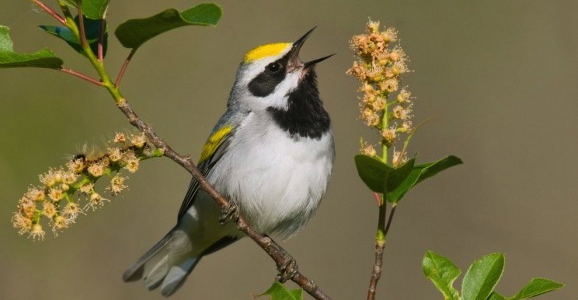Birds May Be Able To “Hear” Approaching Storms, Here’s How
This article is more than 2 years old
 Animals are known for their ability to sense inclement weather before it arrives—horses get agitated, dogs get hyper and weird. As skies darken and wind kicks up, animals generally demonstrate that they know something’s up. But a new study on golden-winged warblers suggests that birds may have weather forecasting abilities that far eclipse anything we’ve previously observed.
Animals are known for their ability to sense inclement weather before it arrives—horses get agitated, dogs get hyper and weird. As skies darken and wind kicks up, animals generally demonstrate that they know something’s up. But a new study on golden-winged warblers suggests that birds may have weather forecasting abilities that far eclipse anything we’ve previously observed.
Back in April, severe weather, including tornadoes, ripped through the Great Plains. In Tennessee, the warblers were busy breeding, when suddenly they took off and headed to Florida. Either they wanted to retire and play shuffleboard, or something else was going on. In a study published in Current Biology, researchers from the University of Tennessee and the University of Minnesota theorize that the birds were able to hear the incoming storms more than 24 hours before they hit thanks to something called “infrasound,” which is a low-frequency noise humans can’t hear.
The researchers didn’t intend to study this ability—they were simply observing the birds’ migration patterns, which typically leads them to the Great Lake and Appalachian region for breeding, and the researchers put tiny geolocators on a bunch of warblers to record their movements. In April, they headed to eastern Tennessee to the Cumberland Mountains to get a peek at the birds, but they weren’t there. The geolocators revealed something downright odd: that the birds had diverted to the Sunshine State. Essentially, they evacuated to a region just outside of the storm’s path.
A few days later, the warblers returned to Tennessee. Normally, birds wouldn’t make such a long and tiring detour (900 miles) right in the midst of breeding, so the researchers knew something interrupted their usual pattern. While they can’t say with absolute certainty that the birds sensed the incoming storms—storms that accounted for roughly 84 different tornadoes, 35 deaths, and over $1 billion in damage—they believe the infrasound associated with the severe weather system was a “probable cue.”
The theory is consistent with other migratory behavior, especially birds’ abilities to navigate high in the air without getting lost. It also makes sense given that scientists have never seen birds getting tossed around in rough weather, which has prompted many to wonder where the birds hunker down during storms. It’s the first time scientists have observed what essentially appears to be evasive action when it comes to severe weather. Too bad the they don’t have their own weather channel.












